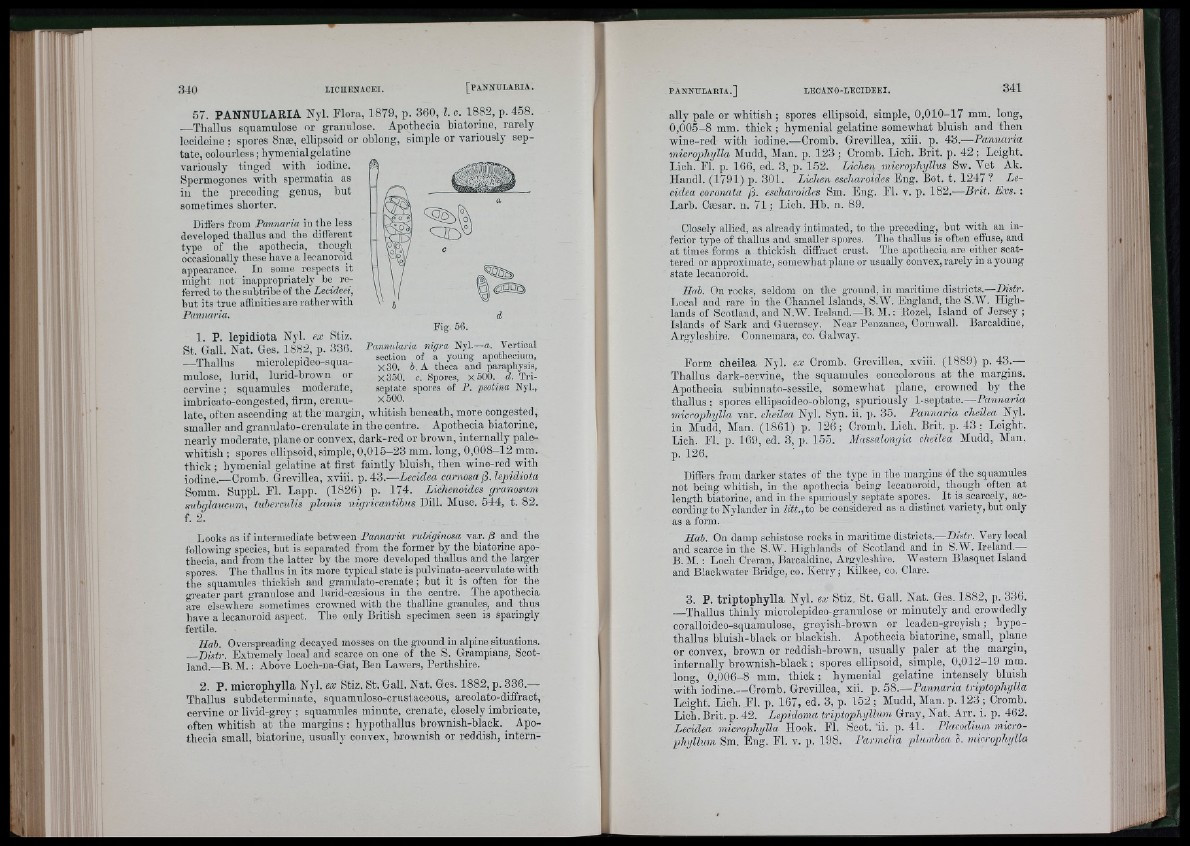
57. PANNULARIA Nyl. Flora, 1879, p. 360, I. c. 1882, p. 458.
Thallus squamulose nr granulose. Apothecia biatorine, rarely
lecideine ; spores Snse, ellipsoid or oblong, simple or variously septate,
colourless; hymenial gelatine
variously tinged w ith iodine.
Spermogones w ith spermatia as
iu th e preceding genus, hu t
sometimes shorter.
Difl’ers from Pannaria in the less
developed thallus and the dilierent
type of the apothecia, though
occasioually these have a lecanoroid
appearance. In some respects it
might not inappropriately be referred
to the subtrihe of the Lecideei,
but its true affinities are rather with
Pannaria.
Fig. .56.
Pannularia nigra Njh—a. Vertical
section of a young apothecium,
X30. 6, A theca and paraphysis,
X3.50. 0 . Spores, x500. d. Tri-
seplate spores of P. psotina Kyi.,
XoOO.
1. P. lepidiota Nyl. ex Stiz.
St. Gall. Nat. Ges. 1882, p. 336.
—Thallus microlepideo-squamulose,
lurid, lurid-brown or
c e rv in e ; squamules moderate,
imbricato-congested, firm, creuu-
late, often ascending a t the margin, whitish beneath, more congested,
smaller and g ran ulato-crenulate in tho centre. Apothecia biatorine,
nearly moderate, p lane or convex, d a rk-red or brown, in ternally palo-
whitish ; spores ellipsoid, simple, 0 ,0 1 5 -2 3 mm. long, 0 ,0 0 8 -1 2 mm.
thiok ; hymenial gelatine a t firet faintly bluish, th en wine-red with
iodine.—Cromb. Grevillea, xviii. p. 43.— Lecidea cariiosa ft. lejjidiota
Somm. Suppl. F l. .Lapp. (1826) p. 174. Lichenoides granosum
svhgiaucmn, tuherculis p lu n is nigricantihus Dill, Muse. 544, t. 82.
f. 2.
Looks as if intermediate betweeu Pamiarim rubiginosa var. ft and the
following species, but is separated from the former by the biatorine apothecia,
and from the latter by the more developed thallus and the larger
spores. I ’he thallus in its more typical state is pulvinato-acervulate with
the squamules thickish and granulato-crenate; but it is often for the
gi'eater part granulose and lurid-cffisious iu the centre. The apothecia
are elsewhere sometimes crowned with the thalline granules, and thus
have a lecanoroid aspect. The only British siiecimen seen is sparingly
fertile.
Hab. Overspreading decayed mosses on the ground iu alpine situations.
Bistr. Extremely focal and scarce on one of the S. Grampians, Scotjand.
B. M. ; Above Loch-na-Gat, Ben Lawers, Perthshire.
2. P. microphylla Nyl. ex Stiz. St. Gall. Nat. Ges. 1882, p. 336.—
Thallus subdeterminate, squamuloso-crusf.aooous, areolato-diffract,
cervine or livid-grey ; squamules minute, crenate, closely imbricate,
often whitish a t the margins ; hypothallus brownish-black. Apothecia
small, biatorine, usually convex, brownish or reddish, in te rn -
i
ally pale or whitish ; spores ellipsoid, simple, 0 ,0 1 0 -1 7 mm. long,
0 ,0 0 5 -8 mm. thiok ; hymenial gelatine somewhat bluish and th en
wine-red w ith iodine.—Cromb. Grevillea, xiii. p. 4 3 .— Pannaria
microgyhylla Mudd, Man. p. 123 ; Cromb. Lioh. Brit. p. 42 ; Leight.
Lioh. FÌ. p. 160, ed. 3, p. 152. Lichen microphyllus Sw. Vet Ak.
Handl. (1791) p. 301. Lichen escharoides Eng. Bot. t. 1247? Lecidea
coronata ft. escharoides Sm. Eng. El. v. p. 182.—B rit. Exs. :
Larb. Cæsar. n. 71 ; Lich. Hb. n. 89.
Closely allied, as already intimated, to the preceding, but with an inferior
type of thallus and smaller spores. The thallus is often effuse, and
at times forms a thickish diffract crust. The apothecia are either scattered
or approximate, somewhat plane or usually convex, rarely iu a young
state lecanoroid.
Hah. On rocks, seldom on the ground, in maritime districts.—Ikstr.
I.ocal and rare in the Ghannel Islands, S.W. England, the S.W. Highlands
of Scotland, and N.W. Ireland.—B. M.; Rozel, Island of Jersey ;
Islands of Sark and Guernsey. Near Penzance, Oornwall. Barcaldine,
Argyleshire. Connemara, co. Galway.
Eorm cheilea Nyl. ex Cromb. Grevillea. xviii. (1889) p. 43.—
Thallus dark-oerviue, th e squamules concolorous a t th e margins.
Apotheoia subinnatn-sessile, somewhat plane, crowned by the
th a llu s ; spores ellipsoideo-oblong, spuriously 1 -septate.— Pannaria
microphylla var. cheilea Nyl. Syn. ii. p. 35. Pannaria cheilea Nyl.
in Mudd, Man. (1861) p. 1 2 6 ; Cromb. Lich. Brit. p. 4 3 ; Loight.
Lioh. El. p. 169, ed. 3, p. 155. Massalongia cheilea Mudd, Man.
p. 126.
Differs from darker states of the type in the margius of the squamules
not being wliitish, in the apothecia being lecanoroid, though often at
length hiatoriue, and in the spuriously septate spores. I t is scarcely, according
to Nylander in litt.,to be considered as a distinct variety, but only
as a form.
Hab. On damp schistose rocks in maritime districts.—Dlsir. V'ery focal
and scarce in the S.AV. Highlands of Scotland and in S.W. Ireland.
B. M. : Loch Creran, Barcaldine, Argyleshire. Western Blasquet Island
and Blackwater Bridge, co. Kerry; Kilkee, co. Clare.
3. P. triptophylla Nyl. ex Stiz. St. Gall. Nat. Ges. 1882, p. 336.
—ThaUus th in ly miorolepideo-granulose or minutely and crowdedly
coralloideo-sqiiamulose, greyish-brown or leaden-greyish ; hypothallus
bluish-blaok or blackish. Apotheoia biatorine, small, plane
or convex, brown or reddish-brown, usually paler a t the margin,
inte rn ally brownish-blaok ; spores ellipsoid, simple, 0,0 1 2 -1 9 mm.
long, 0 ,0 0 6 -8 mm. th io k ; hymenial gelatine intensely bluish
w ith iodine.—Cromb. Grovillea, xii. p. 58.— Pannaria triptophylla
Leight. Lioh. El. p. 167, ed. 3, p. 152 ; Mudd, Man. p. 123_; Croinb.
Lich. B rit. p. 42. Lepidoma triptophyllum Gray, Nat. Arr. i. p. 462.
Lecidea microphylla Hook. Fl. Scot. ‘ii. p. 41. Plcicodium micro-
ph y llm n Sm. Eug. El. v. p. 108. Parmelia plumbea ?. microphylla
i lu '